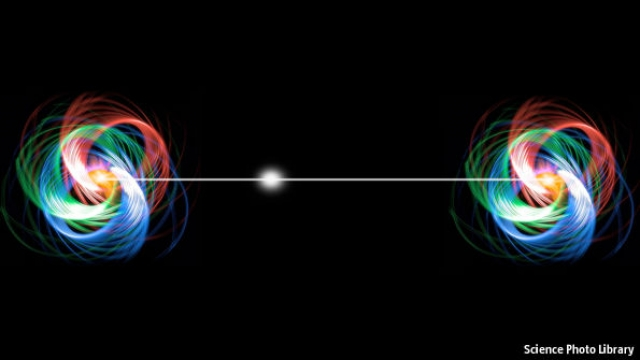Spooky action at a distance
Why some things are neither here nor there
Spooky action at a distance
One of the phrases of Albert Einstein, a quotable physicist, that has leaked into the popular consciousness is “spooky action at a distance”. The derisive quotelet arose during the early days of quantum mechanics, a theory that powered a revolution in science that is still playing out. None of today’s gadgets, for example, could have been made without a deep understanding and exploitation of the theory’s basic tenets. Yet those ground rules come with other predictions so counterintuitive that Einstein came to think that the theory was missing something: what seemed odd was, he argued, just a reflection of a lack of knowledge. He railed in particular at the notion of “entanglement”, whereby two particles seem intimately linked (pictured, conceptually). But what is it, and what made him reckon it was spooky?
Quantum mechanics was so revolutionary because it upended how the atomic-level world was to be described. Gone were the simple certainties of Isaac Newton’s physics, replaced with only probabilities of this outcome or that. A subatomic particle is neither here nor there, the theory suggested; until you measure it, it is both. Some subatomic interactions give rise to new pairs of particles flying off in different directions. Each of these, the theory said, could not be individually described: query one and you learn something instantaneously about the other, even if it is in a galaxy far, far away. That looked to Einstein like information moving instantaneously — ie, faster than light, which his own special theory of relativity said was a universal no-no. In a letter to Niels Bohr, a Danish physicist with whom Einstein had his most vociferous disagreements about the phenomenon, he called it spukhafte Fernwirkung: a “spooky remote effect”.
In 1935 Einstein teamed up with Boris Podolsky and Nathan Rosen, a couple of fellow doubters, to devise a paradox meant to show that quantum theory was incomplete. Ensuing “hidden-variable theories” tried to fill the gap, suggesting some as-yet unknown force was at work. Then experimentalists got to work. In 1950 Chien-Shiung Wu, the “First Lady of Physics”, working at Columbia University in New York, showed that entangled particles indeed behaved as quantum mechanics predicted. In 1964 John Bell, a Northern Irish physicist, proposed a testable boundary between Einstein’s beloved hidden variables and the quantum mechanics that had no need for them. A string of ever-cleverer experiments played out over decades, chasing all the loopholes through which hidden variables might exert an influence. Yet it was not until late 2015 that experimentalists got good enough at manipulating quantum systems to eliminate all those loopholes. Information wasn’t travelling faster than light — Einstein was right about that limit, at least — but, spooky or not, entanglement was inked into physics history.
All this has far greater implications than just resolving physicists’ fisticuffs. I

No comments:
Post a Comment